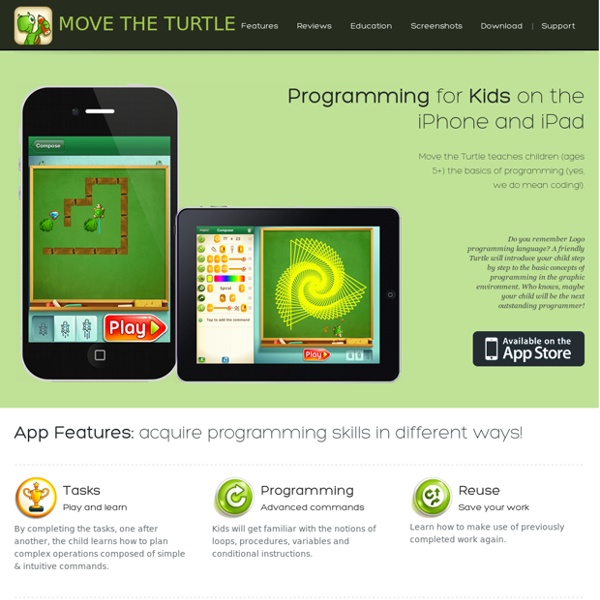



Cargo-Bot – iPad The first game programmed entirely on iPad® Be Logical. Play Cargo-Bot Teacher led Hour of Code lesson plans - by grade and subject Now that tens of thousands of educators have tried the Hour of Code, many classrooms are ready for more creative, less one-size-fits-all activities that teach the basics of computer science. To help teachers find inspiration, we collected and curated one-hour teacher-led lesson and activity plans designed for different subject areas for Hour of Code veterans. Elementary School Scratch Animate Your Name Ages 8 to 16. Programming, Creativity, Web-based. Students will animate the letters of their name, initials, or favorite word using Scratch! CS Fundamentals for grades K-5 Our Computer Science Fundamentals courses have about 15 lessons that may be implemented as one unit or over the course of a semester. Students create computer programs that will help them learn to collaborate with others, develop problem-solving skills, and persist through difficult tasks. They will study programming concepts, computational thinking, digital citizenship, and develop interactive games or stories they can share.
KinderLab Robotics What is KIBO? KIBO is a robot kit specifically designed for young children aged 4-7 years old. With KIBO, children build, program, decorate and bring their own robot to life! STEAM learning with KIBO is fun, imaginative and easy. Scratch Jr. Tutorials for Primary Students Last week, I encouraged you to participate in this year’s Hour of Code. I know that guiding a classroom of students through an hour of programming can sound intimidating, particularly if you aren’t experienced in it yourself. The secret is to do as I have – admit to yourself that you know nothing and your students are smarter than you.
Drawing with Ozobot Ozobot won’t move until at least one of the five bottom sensors sees a color. For instance Ozobot will just patiently sit, wait and blink when placed on a white sheet of paper. Place Ozobot on a dark area, like a wood desk or a black kitchen counter and Ozobot will immediately begin exploring and searching for the next adventure. Tip: Ozobot is Completely obsessed with finding a path and won't hesitate to jump off your dark desk. Drawing a perfect path.
Cool Tools to Help Kids Learn to Code When your kid starts talking about loops, go-to commands, and branches, it probably means she's learning to code, and that's a very good thing. In a technology-fueled world, coding is quickly becoming a prized, 21st-century skill. Plus, it encourages kids to become creators, not just consumers, of the technology they use. Coding apps come in a range of formats designed for different ages and abilities. They often incorporate bright colors, cute characters, and elements of game design to appeal to kids. Beginners typically learn to create programs by dragging and dropping visual blocks of code. Ozobot Bit Adorable robot genius, anyone? These little ‘bots are guaranteed to bust even the most acquainted of minds. (We’re talking about you, nerds.) Ozobot's behaviour is programmed with a doodle, which is fantastic news, because intrigue of human-robot interaction aside, it’s likely been a couple of decades since it was deemed acceptable for you to get your scribble on. Thanks to Ozobot, no longer are illegible markings reserved for infants.
A Beginner’s Guide to Bringing Coding Into the Classroom In case you haven’t been paying attention, computer science skills are vastly becoming some of the most in-demand skills of the twenty-first century. In fact, some call it a new "superpower." But there’s a problem. There are approximately 587,000 computing jobs nationwide, which is growing at 2x the national average, but only about 38,000 computer science students graduated into the workforce this year. Code.org CEO Hadi Partovi Podcast Interview with Kara Swisher It’s easy to mistake computer science for programming, and Code.org CEO Hadi Partovi says that even the kids who will never work for Google or Microsoft should be educated in digital literacy. Partovi joined Re/code Executive Editor Kara Swisher on the latest episode of “Re/code Decode,” where he argued that we should start imparting the basics of computer science to kids in elementary school. “We don’t teach biology or chemistry to kids because they’re going to become surgeons or chemists,” Partovi said. “We teach them about photosynthesis and that water is H2O, or how lightbulbs work, just to understand the world around us. You don’t use any of it, but you do on a day-to-day basis use public-key encryption, and the average American has absolutely no idea what that is.” Vjeran Pavic for Re/code